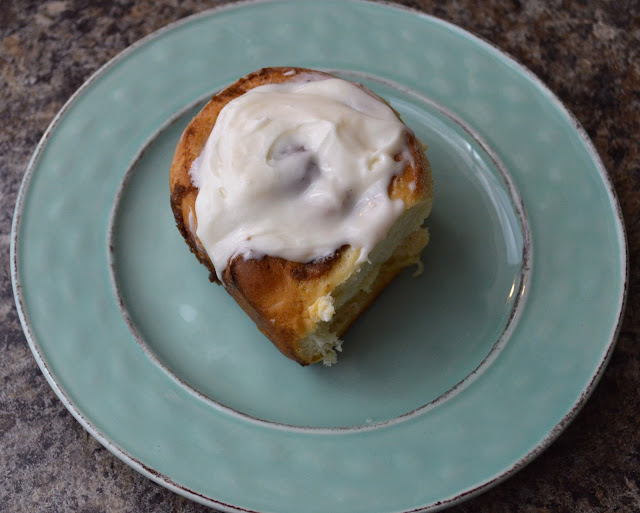Once
again, I’ve found myself away from these pages for longer than I planned. I
hope these rich, decadent, and utterly delicious cinnamon rolls will make up
for that at least a little bit.
I
tried this recipe ages ago. It was originally written to take advantage of the
convenience of a bread machine to make the dough. I did use my bread machine to
make these rolls more than once, but I wore out my bread machine (making this pizza crust hundreds of times) so long ago, I can’t even remember when it was.
This
time, I used my Kitchen Aid stand mixer to make my cinnamon roll dough, which I
find to be nearly as convenient as a bread machine, while offering a little more
control over the recipe as I go. Of course, however you want to make your dough
is just fine, as long as you respect the need for it to be rich with eggs,
milk, butter, and sugar.
This
lovely dough gets spread with butter and loaded with a generous mixture of
brown sugar and cinnamon. A crazy amount of cinnamon. As if all this rich and
wonderful goodness isn’t enough, a cream cheese frosting gets slathered right
on the warm rolls where it melts a bit down into the cinnamon-sugar stuffed
crevasses. They’re absolutely delicious while still fresh and warm, but nothing
will make me turn my nose up at rolls that are even a few days old.
This
pan of cinnamon rolls got me all excited about baking again. They are perfectly
decadent and comforting, great for breakfast, an afternoon snack, or even
dessert. They are also a great example of the reward one can get from a bit of
labor in the kitchen. I wish I could tackle projects like this more often, and such
a good one strengthens my resolve to make more time. Of course, if I manage to
develop that much will power, I’ll have to use it to keep from eating all the
cinnamon rolls!
Cinnamon Rolls
with Cream Cheese Frosting
Adapted
from AllRecipes.com
For
the dough:
1
cup milk
1/3
cup unsalted butter
½
cup sugar, divided
2
¼ teaspoons active dry yeast (1 envelope)
2
eggs, lightly beaten
4
½ cups bread flour, divided
1
teaspoon salt
For
the filling:
1
cup packed brown sugar
2
½ teaspoon cinnamon
1/3
cup unsalted butter, softened
For
the icing:
3
ounces cream cheese, softened
¼
cup unsalted butter, softened
1
½ cup powdered sugar
½
teaspoon vanilla extract
1/8
teaspoon salt
1.
To make the dough: pour the milk and the 1/3 cup butter in a small saucepan.
Heat until the milk is at about 110 F and the butter is melted. (If the milk
gets too hot, allow to cool to 110 F before proceeding).
2.
Pour the milk mixture into the bowl of a stand mixer. Stir in 1 tablespoon
sugar. Stir in the yeast. Let stand about 5 minutes or until the yeast is
foamy.
3.
Stir in the remaining sugar and eggs. Add about 2 cups flour and beat with the paddle
attachment to make a wet batter. Cover with a towel and let stand 15 minutes.
4.
Fit the mixer with the dough hook. Sprinkle the salt over the batter, which
should appear risen and puffy. Knead in as much of the remaining flour as you can
to make a slightly wet and sticky, but smooth dough. Knead for a total of about
10 minutes.
5.
Spray a large bowl with nonstick cooking spray. Shape the kneaded dough into a
smooth ball. Place the dough in the bowl. Spray the top of the dough with cooking
spray. Place a sheet of plastic wrap on top of the dough. Cover with a towel
and let stand for 1 hour or until doubled in size.
6.
While the dough is rising, make the filling. In medium-size bowl, combine the
brown sugar and cinnamon. Stir together until well-combined. Set aside.
7.
Spray a 13 x 9-inch baking pan with nonstick cooking spray. Set aside. Deflate
the risen dough and shape into a new ball. Cover and let rest for about 5
minutes.
8.
On a well-floured surface, roll the dough out into a 15 x 20-inch rectangle. If
the dough springs back rather than rolling out easily, cover and let rest a few
minutes until it is easier to work with. Spread the 1/3 cup soft butter evenly
over the dough rectangle. Sprinkle the filling mixture evenly over the butter.
9.
Beginning with a long side of the dough rectangle, roll up the dough. Cut into
12 rolls. Place the rolls, cut sides up in the prepared baking pan, leaving
room between each roll for the dough to rise. Cover with a towel and let stand
about 30-40 minutes or until the rolls have roughly doubled in size and filled
the pan.
10.
Preheat the oven to 400 F. Bake the rolls about 20 minutes or until golden
brown. Remove from the oven.
11.
Make the icing: Combine the cream cheese, butter and vanilla in a medium-size
bowl. Beat with an electric mixer until smooth. Beat in the powdered sugar and
salt until smooth. Spread the icing over the warm rolls and let stand until
cool enough to eat.
Makes
12 rolls.
One
year ago: Cherry Almond Scones









